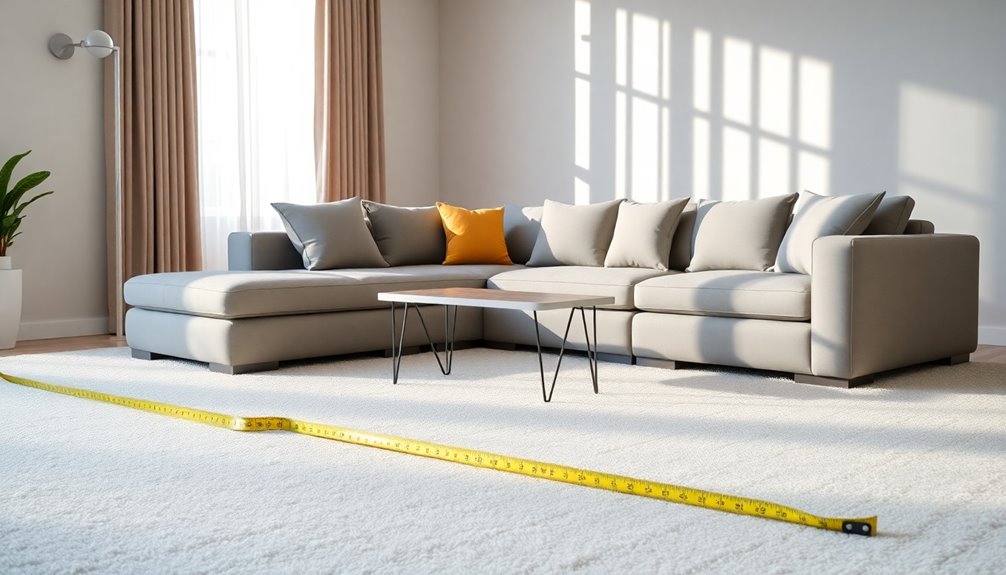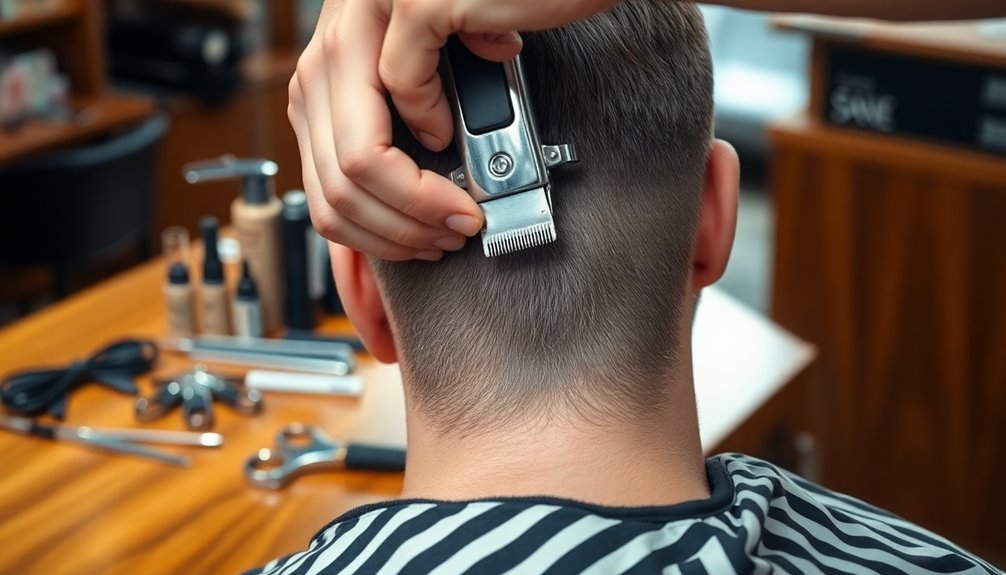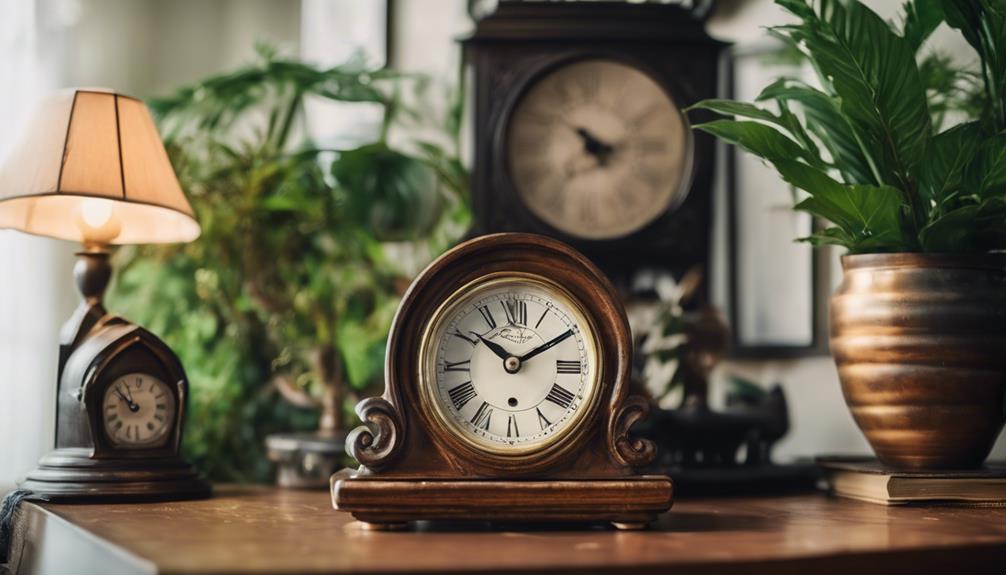To measure for a sectional sofa, start by determining your room's total dimensions, including length, width, and height. Make note of doorways and pathways for easy access. Use a tape measure to get the length, depth, and height of each sectional piece, including any chaise or recliner components. Aim for at least 30 inches of additional space for movement around the sofa. Don't forget to assess seat height and backrest support for comfort. Accurate measurements will help you select the perfect sectional. If you stay with us, you'll uncover more tips on choosing and maintaining your sofa.
Key Takeaways
- Measure the total room dimensions, including length, width, and height, to ensure the sectional will fit comfortably.
- Assess doorways and pathways for access, allowing at least 30 inches of space for movement around the sectional.
- Measure each section of the sectional individually, including depth, height, and any chaise or recliner components.
- Use a tape measure for accuracy, noting all dimensions, and consider additional cushions when measuring.
- Test different configurations with temporary markers or tape to find the best layout for comfort and flow.
Introduction

When you invest in a sectional sofa, protecting its fabric is key to maintaining its look and longevity. You'll want to know the right cleaning techniques for different materials, especially when tackling pesky stains like wine or coffee. Let's explore how to keep your sectional looking its best with routine treatments and specific care tips.
Routine Fabric Protection Treatment
To keep your sectional sofa looking its best, routine fabric protection treatments are essential. These treatments create a barrier against spills and stains, helping to significantly extend the lifespan of your upholstery. By applying fabric protection, you can reduce the frequency of cleaning, as dirt and liquids are repelled, making it easier to maintain a fresh appearance.
When considering the overall dimensions of your sectional sofa and the measurements of the interior space, remember that protecting your investment is just as important as choosing the right size for comfort and style. Regular treatment is recommended every 6 to 12 months, depending on how often you use your sofa and its exposure to potential stains.
Fortunately, most fabric protection treatments are safe for a variety of materials, including cotton and polyester blends, ensuring versatility in application. Plus, many options are eco-friendly and non-toxic, making them safe for homes with children and pets. By incorporating routine fabric protection into your maintenance schedule, you can enjoy your sectional sofa's beauty and comfort for years to come.
Fabric-Specific Cleaning Techniques
Maintaining your sectional sofa goes beyond routine fabric protection; it also involves using the right cleaning techniques tailored to each fabric type. Different fabrics require specific cleaning methods. For instance, you can often clean microfiber with a mix of soap and water, while leather needs a specialized cleaner to avoid damage. Always check the manufacturer's care label before cleaning to understand the recommended techniques and products.
For stain removal, it's crucial to act quickly. Blot the area with a clean cloth instead of rubbing, which can spread the stain or damage the upholstery. Additionally, steam cleaning can be effective for many types of upholstery, but ensure the fabric is compatible to avoid water damage or shrinkage.
Regular maintenance is essential. Vacuum your sectional regularly and consider using fabric protectors to help prolong the life of your sofa and keep the fabric looking fresh. By following these fabric-specific cleaning techniques, you'll maintain both the appearance and durability of your sectional sofa, ensuring it remains a stylish and comfortable centerpiece in your living space for years to come.
Tackling Wine and Coffee Stains
Wine and coffee stains can be a homeowner's worst nightmare, especially on your beloved sectional sofa. The key to tackling these stains is quick action. For wine stains, start by blotting the area immediately with a clean cloth to absorb excess liquid. Once you've done that, mix a cleaning solution of dish soap and white vinegar, and gently apply it to the stain. Remember, never scrub vigorously, as this can spread the stain or damage the fabric fibers.
When it comes to coffee stains, the same principle applies. Blot the stain with cold water first, then use a solution of mild detergent mixed with water to lift the stain away. Always test any cleaning solution on an inconspicuous area of the fabric to avoid discoloration.
After treating the stains, let the area air dry completely. To measure your sofa's protection against future spills, consider applying a fabric protector spray, which can help prevent stains from setting in. Keeping your sectional sofa looking pristine is all about prompt and gentle care for those pesky stains!
Stain-Resistant Fabric Treatments

When choosing a sectional sofa, consider stain-resistant fabric treatments to keep your furniture looking fresh. You can also explore scratch-resistant options and stylish fabric protectors that blend functionality with aesthetics. Durable fabric choices not only enhance your sofa's longevity but also make maintenance a breeze.
Scratch-Resistant Fabric Options
How can you ensure your sectional sofa withstands the chaos of everyday life? Choosing scratch-resistant fabrics is a great start. These materials are specifically designed to handle wear and tear, making them perfect for homes with pets or kids. Many of these fabrics utilize nylon or polyester blends, enhancing durability while still feeling soft to the touch.
When selecting your sofa, remember to measure the height, width, and overall depth to ensure a perfect fit in your space. Look for fabrics with a tight weave construction, which helps prevent snags and enhances resilience against scratching.
To further protect your investment, consider stain-resistant fabric treatments like Teflon or Scotchgard, which can be applied to scratch-resistant materials. This combination not only guards against spills but also significantly extends the lifespan of your sectional sofa, reducing the need for costly repairs or replacements over time. Incorporating natural elements into your living area can also enhance the overall ambiance and comfort of your space.
Opt for Stylish Fabric Protectors
To keep your sectional sofa looking great and lasting longer, opting for stylish fabric protectors is a smart move. These stain-resistant treatments create a liquids barrier that repels spills and stains, making cleanup a breeze. By applying these protectors to various upholstery fabrics, including cotton, linen, and synthetic blends, you can easily match your sectional's style while ensuring durability.
Advanced technology, like nano-coating, allows these treatments to guard against liquids without changing the fabric's texture or appearance. Regular maintenance and reapplication are key to enhancing their effectiveness, with some treatments lasting for several years before needing renewal. This means you won't have to worry about frequent professional cleaning, saving you time and money.
Moreover, choosing stain-resistant fabric treatments doesn't compromise your sofa's aesthetic appeal. In fact, it helps maintain the beauty of your upholstery fabrics, allowing you to enjoy your sectional without the stress of potential stains. With stylish fabric protectors in place, you can relax knowing your sofa is protected and your investment is safeguarded for years to come. Additionally, maintaining a clean home environment can also reduce allergens and pollutants, contributing to overall health and wellness.
Durable Fabric Choices
Durability is a key factor to consider when selecting fabrics for your sectional sofa, especially if you want to maintain its appearance over time. Opting for stain-resistant fabric treatments can significantly enhance your sofa's longevity. Technologies like Teflon or Nano create a protective barrier that repels spills and dirt, making cleaning a breeze.
Fabrics such as microfiber and performance polyester are popular choices for their stain-resistant qualities. They offer both durability and a soft feel, making them perfect for everyday use, particularly in homes with children or pets. You'll appreciate how these fabrics withstand common household stains like food, wine, and pet accidents, allowing you to enjoy your sofa without constant worry.
When shopping, look for "sofa-grade" fabrics, as these indicate higher durability and resistance to wear and tear. Keep in mind that while stain-resistant treatments are effective, they can wear off over time. Regular maintenance and following the manufacturer's care instructions are essential to keep that protective barrier intact. By choosing the right durable fabric, your sectional sofa will not only look great but also stand the test of time.
Upholstery Stitching Integrity

When you're choosing a sectional sofa, pay close attention to the upholstery stitching integrity. Strong seams not only enhance the overall durability but also complement the frame stability, cushion resilience, and support. By ensuring high-quality stitching, you're investing in a piece that'll hold up over time.
Frame Stability Concerns
Ensuring frame stability in a sectional sofa hinges on the quality of its construction, particularly the integrity of upholstery stitching. A well-built sectional should use robust construction materials, like hardwood for the frame and high-quality plywood for support. This foundation contributes to overall durability, helping the sofa withstand daily use.
Upholstery stitching plays a vital role in maintaining frame stability. Tight and even stitching prevents seams from unraveling, enhancing the fabric's longevity. Look for reinforced corners and joints; these features ensure that the frame remains stable and retains its shape, even under heavy use.
Moreover, high-density foam in cushions adds another layer of support, preventing sagging and wear over time. Regular inspections of the stitching and frame joints are essential. They allow you to identify potential issues early, ensuring that the structural integrity of your sectional is maintained. By prioritizing these aspects, you can enjoy a sectional sofa that not only meets your aesthetic needs but also stands the test of time. Taking these steps will ensure that your investment remains comfortable and reliable for years to come.
Leather Repair Techniques
Maintaining the integrity of upholstery stitching is vital for the longevity and appearance of your leather sectional. Well-stitched seams not only enhance durability but also prevent unraveling and fraying over time. When you notice any stitching failures, don't panic; there are effective repair techniques you can use.
One common method is re-stitching with a heavy-duty thread and needle specifically designed for leather. This ensures your repairs are strong and long-lasting. Leather repair kits can be invaluable for these projects, as they typically include specialized adhesives and stitching tools. With the right kit, you can reinforce or replace damaged seams without needing professional help.
When you embark on a repair, it's essential to match the thread color and type to the original stitching. This attention to detail helps maintain a cohesive look and avoids noticeable repairs. Additionally, regular maintenance, like cleaning and conditioning your leather, can help preserve the integrity of the stitching. Proper care prevents the leather from drying out and cracking, which can lead to further stitching failures down the line. So, keep an eye on your leather sectionals to ensure they stay in excellent condition!
Cushion Resilience and Support
Cushion resilience plays a crucial role in the comfort and longevity of your sectional sofa. It refers to the ability of the cushions to retain their shape and support over time. When selecting a sofa, pay attention to the quality of the foam used, especially high-density foam, as it offers better durability and support. A well-constructed cushion typically combines multiple layers of materials, including down or synthetic fibers, enhancing both comfort and resilience.
Equally important is upholstery stitching integrity. Strong stitching prevents seams from unraveling, maintaining the overall structure of the cushions and fabric. Look for features like double-stitched seams or reinforced corners, as these contribute to the durability of your sectional sofa. Regular maintenance, such as fluffing cushions and checking for loose threads, can significantly extend the lifespan of your upholstery while keeping cushion support intact.
Custom Fabric and Color Options
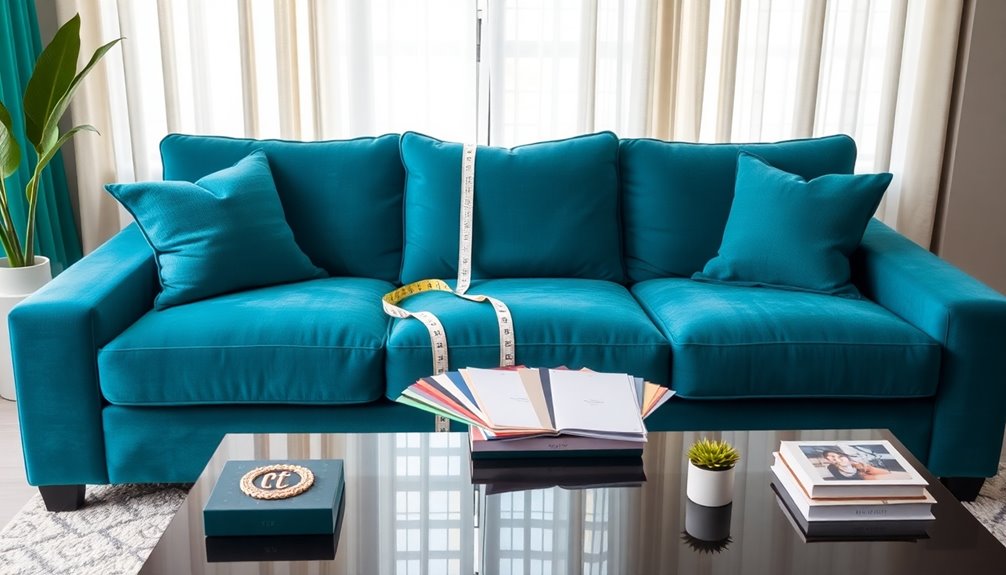
When you're ready to personalize your sectional sofa, exploring custom fabric and color options can truly elevate your space. With a variety of custom fabric options available, you can choose materials like leather, microfiber, or woven textiles that offer personalized comfort and style. This flexibility allows you to select the perfect fabric that suits your lifestyle and preferences.
Many retailers provide an extensive range of color choices, enabling you to pick shades that complement your existing decor. Whether you prefer bold hues or subtle neutrals, there's something for everyone. To help you visualize your options, some manufacturers also offer fabric swatches, making it easier to see how different materials will look in your home.
Don't forget to consider patterns and textures, as these elements can enhance the aesthetic appeal of your sectional. You can opt for stripes, florals, or solid colors to create a vibe that resonates with you. Additionally, certain brands allow you to mix and match different fabrics and colors across various sections of the sofa, giving you the freedom to design a truly unique look that reflects your personal style.
Incorporating earthy color palettes can harmonize your sectional with a Balinese-inspired interior design, enhancing the overall warmth and serenity of your space.
Routine Maintenance and Repairs
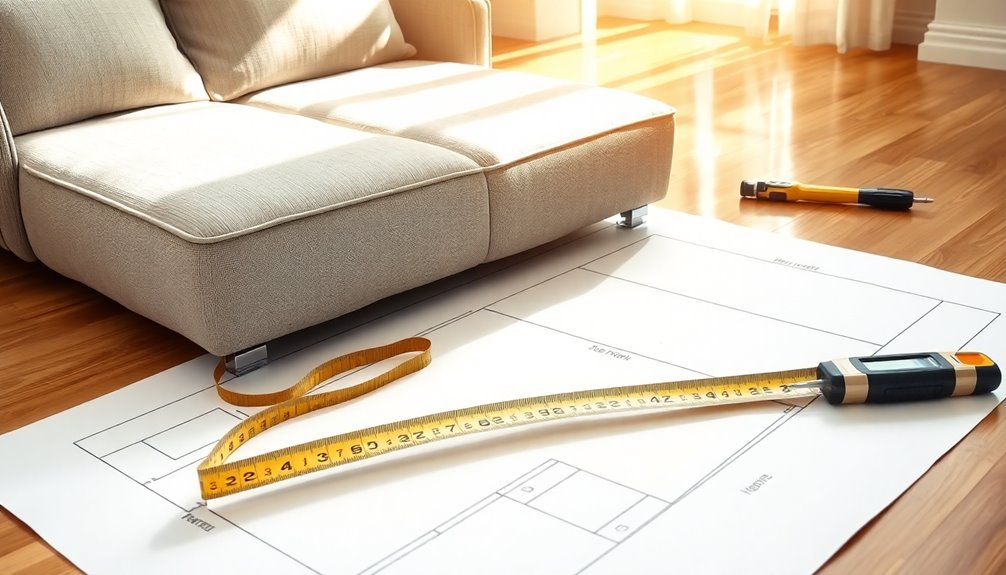
Keeping your sectional sofa in top shape requires regular care and attention. Start with routine maintenance by vacuuming your sofa to eliminate dust, dirt, and debris that can wear down the fabric or leather, affecting its appearance over time. When spills happen, use a soft cloth and a mild soap solution to spot clean stains immediately; this proactive approach can prevent permanent damage. Additionally, consider using fabric protectors or sprays that can help repel stains and minimize wear. If you ever decide to part with your sectional sofa, understanding how to effectively sell a sofa can significantly impact your success. Highlight its features, condition, and any unique characteristics to attract potential buyers and ensure a smooth transaction.
If you have a fabric sectional, consider applying a fabric protector spray. This creates a barrier against future spills and stains, extending the life of your sofa. Don't forget to inspect it regularly for loose screws or bolts. Tightening these will ensure stability and prevent structural issues that could compromise comfort.
Additionally, if you notice sagging cushions, make it a habit to rotate or fluff them regularly. Replacing foam or filling when necessary will maintain the support and comfort you expect from your sectional. Keeping these maintenance practices in mind will not only enhance the sofa's longevity but also ensure that it remains a cozy and stylish centerpiece in your home.
Conclusion

In conclusion, measuring for a sectional sofa is crucial to ensuring it fits perfectly in your space and enhances your home's comfort and style. Start by determining the overall width and overall length you need, typically ranging from 94 to 168 inches in width and 94 to 156 inches in length. This will help you visualize how the sectional can comfortably fit within your room.
Always remember to maintain at least 30 inches of walking space around the sectional to promote accessibility and avoid blocking pathways or doors. A smart tip is to use painter's tape to outline the dimensions on your floor, giving you a clear picture of your layout.
Don't forget to measure doorways and hallways to confirm your selected sectional can be delivered without any obstructions. If necessary, consider removing the legs for easier entry. Lastly, take note of the height from the floor to the arms and back to ensure it fits well within the vertical space, particularly regarding windows or wall art. By following these steps in measuring for a sectional, you'll achieve a perfect fit that elevates your living area.
Frequently Asked Questions
How Large Should a Sectional Be in a Room?
To ensure your sectional fits well in the room, aim for it to occupy about 2/3 of the total space. This balance creates an inviting atmosphere. You should also leave at least 30 inches of walking space around it for easy movement. Plus, maintaining 18 inches between the sectional and coffee table allows for comfortable access. Remember, the sectional's length typically ranges from 94 to 156 inches, so choose wisely!
How Do You Measure if a Sofa Will Fit?
To measure if a sofa will fit, start by checking the space where you want it. Measure the width and length, allowing for at least 30 inches of walking space around it. Use painter's tape to outline the sofa's dimensions on the floor, giving you a clear visual. Don't forget to measure doorways and hallways to ensure it can fit through tight spaces during delivery. Lastly, consider the height and depth for overall comfort.
What Is the Average Size of an L-Shaped Couch?
The average size of an L-shaped couch ranges from 94 to 156 inches in length and from 94 to 168 inches in width. This design offers plenty of seating for larger spaces, comfortably accommodating 5 to 8 people. You'll also notice that the chaise length can vary, which affects overall dimensions. Remember to consider at least 30 inches of clearance around the couch to ensure easy movement and accessibility in your living area.
What Size Sofa for a 12X12 Room in Inches?
For a 12×12 room, you'll want a sofa that's around 80 to 100 inches in overall length. This size helps create a comfortable vibe without overwhelming your space. Aim for a width between 90 and 120 inches to ensure ample seating. Remember to leave at least 30 inches of walking space around your sofa for easy movement. If the dimensions feel too tight, consider low-profile designs to keep the area feeling open and inviting.
